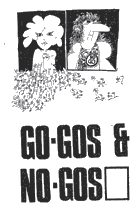MELBOURNE MUSIC IN PRINT – Go-Set Magazine – February 1966 to August 1974.
|
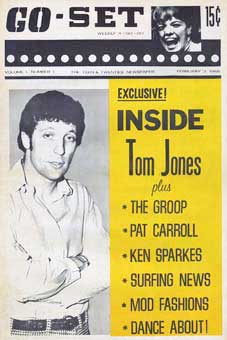 Cover of the first edition of Go-Set, Cover of the first edition of Go-Set, 2 February 1966 |
It was into this climate that Go-Set Magazine was born – a love child from the coupling of new youth oriented journalism and the growing beat and progressive music scene. While not dabbling in pushing the bounds of public decency like other publications, it catered specifically for the teens in the lower age groups and focussed on just what the teenage girls wanted – stories and photos of their music heroes.
Tony Schauble and Phillip Frazer, editors of Monash University’s Lot’s Wife began with
a germ of an idea based on a magazine-style format to deliver the goods to a
music-starved Melbourne audience. Frazer was a member of Monash University’s strong Leftist faction and
brought this philosophy of socialism, rebellion and protest through to Go-Set. In a
dimly lit meeting with Peter Raphael one night, late in
1965 at The Thumpin’ Tum discotheque, they floated the idea to aspiring
photographer, Colin Beard who wanted to be included.
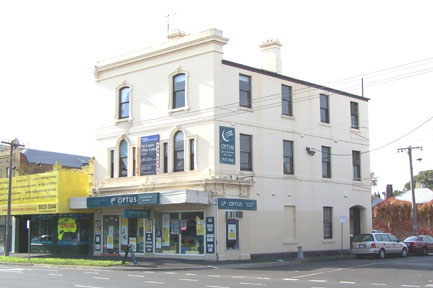
Go-Setís first office on the corner of St. Kilda Road and Charnwood Crescent, St. Kilda. The paper occupied the ground and first floors and several small buildings out the back.† |
The fledgling publication was originally christened with the name, Go-Set Weekly-A-Go-Go and the first edition came out on 5-6 February, 1966. The team moved into their first real office at 2 Charnwood Crescent, St. Kilda in April of that year. However, much of the early work had been done directly from Frazer’s and Schauble’s flat in Malvern, Raphael’s house in Clifton Hill and Beard’s house in Drummond Street, Carlton which he shared with friend, Bill Robinson. Colin Beard set out on his first assignment to photograph The Moods who were being looked after by Raphael:
COLIN BEARD: “I was … taking photographs wherever The Moods played, not only of the band on stage but of the fans, the suburban kids who filled the dance halls …
“Come on, Tony and Phillip have a look at these,” Peter insisted one day.
They were both thrilled with them, and we sat down and we worked out an idea. There would be a double page spread of photographs at dance halls, photographs of the bands and snapshots of the fans with their names underneath, ‘seen at Ormond Hall’, seen at Mordialloc Town Hall. It would be a regular feature called “The Scene – The Seen”, did I want to do it? Of course I did. There was no money, Tony and Phillip could hardly feed themselves. But I didn’t want money. I wanted to be a photographer.” (Beard, unpublished biography, Chapter 13, P2.)
 Photo from Wyn Hatwell, "Wandering Around Waverley" |
Beard’s first real photographic assignment was for this very first Go-Set edition and he accompanied Doug Panther who was to interview touring stars, Tom Jones and Herman’s Hermits. They made it to the stage door at The Palais, St Kilda and were actually welcomed in by the stars who were happy to have someone to chat with until show time. Beard had a 3am deadline to deliver his photos to the printers, Waverley Offset Printers, a deadline he was able to meet. Within a short time, Beard found his first photos adorning the cover of the first Go-Set to be produced.
Waverley Offset Printers had
previously published Lot’s Wife for Frazer, using Webb offset printing
techniques employed for their main paper, the south-eastern suburban Waverley
Gazette. Go-Set was first printed by
Waverley Offset at its small, but modern print works in Railway Parade, Glen
Waverley and it remained this way until January, 1972 when printing was
transferred to the new Waverley Offset factory in Geddes Street, Mulgrave.
Waverley Offset Printers also held shares in Go-Set Pty Ltd and this business
connection was to be significant down the track.
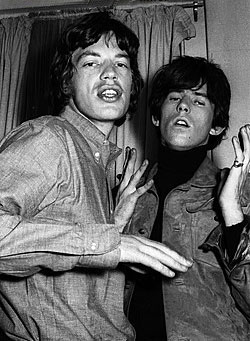 photographed by Colin Beard in 1966 |
Those who were there with Schauble, (Editor) and Fraser, (Designer), Beard, (photographer) and Raphael, (advertising manager) when the magazine commenced in 1966 were: Terry Cleary (advertising sales), Doug Panther (writer), Kestin “Honey” Lea (everything- later fashion editor) and Vera Kaas-Jaeger (photo assistant). Ian ‘Molly’ Meldrum arrived some five months into the magazine’s existence and he was given his first writing job by Beard. Lily Brett had joined only a few months before Meldrum, who was to become Go-Set’s most famous staffer. Such was the precarious nature of this venture that it was doubtful if the magazine would survive its first year; Raphael was initially convinced that it would last only two or three issues:
COLIN BEARD: “So many have written about Go-Set but very few people know what happened. The long hours, the moments of inspiration, the struggles against VANA who tried to kill it off, trying to scratch for food, for film, for transport. For the first few months it was touch and go whether we would survive. Tony Schauble was the towering pillar of strength. His encouragement and unflinching will and energy kept us all going - often without sleep and food. It is sinful to rob him of due credit. He was the single most important ingredient in the survival and the success of Go-Set. John Ford tried to keep a grip on the business side of things and he had a car - no one else did until Lily (Brett) came along.”(Beard, op cit 27 February, 2006)
Go-Set was initially distributed to newsagents around the city and suburbs by Collins Distributors until Beard’s flatmate Bill Robinson stepped in:
COLIN BEARD: “They (Collins) had the infrastructure, but little interest in a new player in the market place. It was delivered to the newsagents every Wednesday morning and left there, buried beneath a stack of assorted specialty magazines … “Do you think Tony and Phillip would be interested in me handling the distribution of Go-Set?” Bill Robinson asked one night. “I have no capital, no established infrastructure but I have the (know) how.” Tony and Phillip were overjoyed. It was a gamble, an unheard of proposition. Collins threatened to sue for breach of contract, but we knew it wasn’t worth their while,…
The first week was chaotic. Bill had got hold of a list of newsagencies from the Victorian Authorised Newsagencies Association, who had no idea what he wanted it for, and he had arranged a deal with a newly established taxi truck company called Aljon.
Shortly after midnight on that first Tuesday morning, students from Monash University arrived by the car load. The magazines followed hot from the presses an hour later and soon, all were frantically wrapping and labelling parcels of Go-Sets from lists provided by Bill and sorting them into delivery districts. By early afternoon it was finished, only a few piles left standing in a corner, in case of reorders. Sleeping bodies were littered all over the house, still in their underwear…” (Beard, unpublished biography, Chapter 14, P3)
Distribution was to cause deep problems, with VANA (the major newsagency group) putting undue pressure on its members not to sell Go-Set. Some newsagents caved in to VANA’s pressure tactics through raw fear and some refused to be bullied by the organisation. In either case, they could not ignore the thirty-thousand units which were being sold and the thousands of teenagers who were asking for the magazine. Then in quick succession, the makeshift magazine found itself making staff changes – some optional, some necessary. Within a short time, Doug Panther had left, citing disagreements with the owners as his reasons. (To the police, he was also a “person of interest” in relation to not registering for National Service commitments). But a strikingly beautiful young, Jewish girl by the name of Lily Brett had arrived.
|
Johnny Young interviews Go-Set's Lily Brett & showcases Normie Rowe in London on the "Go" Show, 1966 |
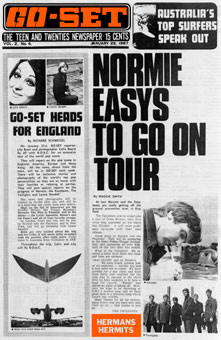 Go-Set cover, January 1967 Lily Brett & Colin Beard head overseas |
Ian McCausland whose poster and record cover designs were to gain him a high level of acclaim, came on board Go-set in 1968 as Art Director, following his win in the poster competition held by the magazine for a poster to promote The Who/Small Faces tour of that same year. For McCausland, it was a defining experience being in the same office as many whose brand of politics supported the leftist tendencies:
IAN McCAUSLAND: “There was a nice mix of people there. It was significant for me, because I’d never gone to university and I’d never had contact with the “Monash Uni. lefties” and there were a lot of those at Go-Set. I sort of changed and became vaguely political… over to their side. I was a northern suburbs boy and hadn’t known anything else and for me to meet the Editor, Phillip Fraser who was a very intelligent guy….was a privilege.” (McCausland, op cit, 4 November, 2005.)
Go-Set cashed in on the desire of the kids to know more about their favourite pop stars, both local and overseas. Michael Edmunds who was there from 1967 to 1971 summed up the appeal of the magazine:
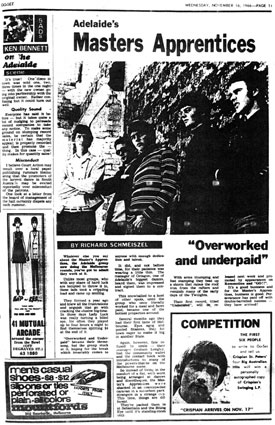 Go-Set, 16 November 1966 |
MICHAEL EDMUNDS: “Go-Set's innovation was to take teenage culture seriously, and give teenagers 'their own newspaper' at a time when other newspapers catered to a middle-class conservatism. As I remember it, we lived in a world that viewed teenage ideas as, at best, immature and trivial, and, at worst, a 'clear and present threat' to our parents' traditions and social values. In getting serious about teenage concerns, while seeking to express the enthusiasm, hedonism, and expectations of the young, as well as their emerging desire for a world without nuclear threats and Cold War one-upmanship, over time, Go-Set evolved a complex, though strong, editorial policy that couldn't help but differentiate it from its mainstream competitors.
In contrast to others (according to anecdotal evidence from former readers, that is: my wife and her friends), Go-Set had more authority, arguably because it was produced by young people for (in fact) younger people, without condescension, and without being patronising or manipulative. One of the great qualities of Go-Set, I think, was its editors' genuine attempts to understand and satisfy their market.
At the same time, though, since the market was very broad, covering a range of diverse tastes, levels of education, age groups, and depths of musical awareness, the content of the magazine had to reflect and cater to this diversity – which meant we had to provide promotional accessibility to almost anyone with, or even wanting, a following.” (Edmunds, op cit www.4.tpgi.com.au)
Go-Set was pushing into uncharted waters and much was experimental. Jim Keays describes the institution which, to the outside observer, seemingly looked ad hoc in nature and run with little or no backing:
JIM KEAYS: “Go-Set magazine, which we would read avidly in Adelaide, was a crazy, unorganised mess but it worked. It was the Bible of Australian music. Basically, it was the only one available, and everyone bought it. … It was run on a shoestring and most of the employees were totally inexperienced. This was quite understandable, considering there’d been nothing like it before, so no experience was possible.” (Keays, 1999. P 51.)
At the outset, Go-Set reflected the music scene at the time. It was just after The Beatles hysteria – the “scream years” had settled down and a mixture of music could be experienced around town – jazz, folk and progressive rock. Go-Set in its first year, 1966 had columns within its pages to reflect the diversity of music emanating from the live venues – there was a “Folk Column” by Mike Coulihan, Blues by Chris Hector, and Jazz by Ross “le jelly roll” Laird as well as the best from the rock scene. Advertisements also showed that the change-over within the venues was happening too, with one, Harlem Jazz at the Caulfield Town Hall having The Red Onions and The Black Eagle Jazz Band playing in the lower area while upstairs – “Up In The Gods” offered, “… Real Candle Light Discotheque atmosphere with crumpets. Coffee and live non-stop folk music.” (Go-Set, 17 August, 1966). Even The Thumpin’ Tum – the rockinest of all discotheques was offering in 1966, a Modern Jazz night every Monday!
Some of the articles were made for light reading only and didn’t attempt to explore the nitty-gritty of the bands music at all. In many cases, they just wanted to know how their idols lived – did they do “normal” things like everyone else? Take this segment from an interview with Ross Hannaford of Daddy Cool and The Party Machine:
Howard: Do animals like you?
Ross: Yes, I’ve been having a lot of success with cats recently. I never got on with cats all my life ‘till the last six months. It’s just the people I come in contact with have all got cats, and they’re real friendly. I mean really, really, friendly and you can play with them and stuff and do anything with them – I mean we’ve got a cat here that fetches sticks like a dog. It’s a really nice cat, really affectionate. I like children too. (Go-Set, 29 July, 1972)
 Go-Set cover, September 1969, featuring Ian Meldrum |
Hmmm… riveting and incisive journalistic stuff! There is no doubt that the young female audience was the major sales target and the magazine was geared to interest and entice them. There were the editorial features about individual pop stars, the fashion and beauty columns, lots of photos, a big cover and the chance to write in – the letters to the editor columns. Within a short period of time, Ian ‘Molly’ Meldrum fresh from his days on Kommotion was on board and churning out major stories (in his own fashion) as well as making news and appearing on the cover of Go-Set himself. Meldrum, it is certain made a significant contribution to the running of Go-Set and to the direction the paper was heading all throughout its existence. He seemed to be well suited to the often chaotic office atmosphere. Colleague Ian McCausland, Art Director from ’69 onwards recalls:
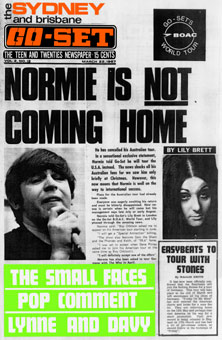 Go-Set cover, March 1967, |
IAN McCAUSLAND: "Oh ... he was great. He was such a hysterical element amongst the staff ... last-minute deadlines… but he always delivered. It was just like… done in dramatic style. He had a great rapport with people. He and Stan Rofe were great friends and they would bait each other. Ian had great contacts and he was always so enthusiastic about the whole scene. He could have been criticized for concentrating on one person, but that was the nature of selling the newspaper. Go-Set was huge at the time so he put all his efforts into that.” (McCausland, op cit, 4 November, 2005)
One of the most popular inclusions in the magazine’ pages over time was certainly Normie Rowe, a teen sensation (Shakin’ All Over) who undoubtedly assisted Go-Set to sell around 40,000 copies per week at this time. Still relatively the same age as the readership of Go-Set – the girls couldn’t get enough of him – literally - as he had his clothes torn off regularly whenever he appeared in public. A very young Ed Nimmervoll, who was intending to spend his working life carving out a career in architecture, like Meldrum had a burning passion for music and began collecting and closely studying the sales charts from around the nation. He had imported his own records before they became hits here and was having overseas “pop” magazines such as Billboard, Cashbox and Musical Express flown direct by airmail about two or three months before they arrived at the local newsagents. On his journey into the city, he would drop off his chart at the Go-Set St. Kilda office:
ED NIMMERVOLL: “So I was getting
all this information for myself and doing the chart for Go-Set and when I
dropped each one in, I started to write little notes on the bottom. Maybe I was
showing-off a bit, I don’t really know, but they started printing this stuff at
the bottom of my chart. They were things I was telling them and I was ahead of
them, delivering some news that they didn’t have in their publication. So they
started putting my name on there. It was the chart, by Ed Nimmervoll and they’d
put a comment on the bottom. So when you look at Go-Set in ’67,
that’s what you see. In time, they became quite curious about me and wanted to
meet me. Particularly Ian Meldrum because he was really into music. So he
wanted to know about this strange
person who was sending this stuff in.” (Nimmervoll, op cit, 23 September, 2005)
 Leslie Pixie column, October 1968 Leslie Pixie column, October 1968 |
Some notable names wrote for Go-Set – Prue Acton (writer – 1966) who had her own fashion column, Lily Brett, (1966-68) reporter on the local music scene and Sue Flett who came up with her column “Beauty Notes” as well as launching the “Dear Lesley Pixie” personal help and advice column. “Beauty Notes” on August 17, 1966 gave advice on which perfume a girl should choose – concentrates, skin perfumes or toilet waters.
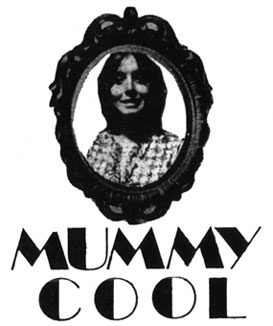 |
Ross Wilson’s then wife, Pat,
who had her own hit, She’s A Bop Girl penned by her husband,
also contributed during 1971-2. with the column “Mummy Cool” which took up from
“Dear Lesley Pixie”. Wilson found that her responses to young readers on sexual
matters embroiled her in some controversy when the Melbourne Truth newspaper
accused Go-Set of going too far. (From a scandal-rag like Truth, isn’t
this a case of the pot calling the kettle black?) Then there was Go-Set’s “Postbox”
and “Go-Gos and No-Nos” which gave the kids a chance to write in to pledge
their undying love for a particular band or artist. Here’s an example:
|
But as well as these contributors and staffers making a significant impact on the direction that Go-Set was moving, the magazine itself and merely the experience of working in the Go-Set office in firstly, St Kilda, then Carlton, could have a profound effect of individuals. Art Director, McCausland remembers when accountant Geoff Watson joined the team in the middle of 1968:
IAN McCAUSLAND: “…they got in an accountant, Geoff Watson and Geoff had come straight from an accounting firm and he used to wear his suit in to work… clean shaven.. immaculate shirts. I remember watching, with fascination, the transition of Geoff. The first sign of change was that his sideboards got a bit longer, then the hair started to grow… missing out on a few regular haircuts… semblance of a moustache. In the end, Geoff Watson was the ultimate hippie. He used to wear caftans to work with wooden beads to go with his shoulder-length blond hair. It was just amazing!” (McCausland, op cit, 4 November, 2005).
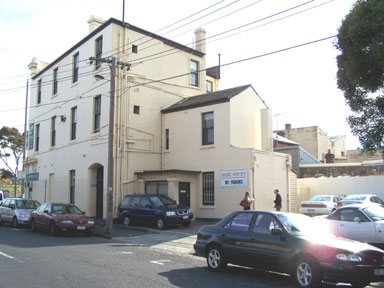 Go-Set occupied the buildings at the rear of 2 Charnwood Crescent and Colin Beardís darkroom was here. |
Several photographers were “employed” by Go-Set in a strange sort of arrangement which was typical of the way Go-Set was run. Right there at the beginning was Colin Beard who tenaciously patrolled the discotheques of the city and surrounds every Friday and Saturday night, with his camera, like some sort of night-stalker. His photographs appear in the pages up until 1968, when he and Lily Brett went overseas on assignment. The last time he worked for Go-Set was to photograph The Monkees tour in September, 1968. Unfortunately, most of the originals and negatives of the early photos that he shot, all but vanished when the magazine folded because Go-Set kept the negatives shot by most of the photographers:
COLIN BEARD: “So many great images I took during those early years have disappeared. Most of the original photos from that time remained in the Go-Set files and are most probably lost. So many lost. If I'd have known the outcomes I would have taken all my photographs with me when I left Go-Set in late 1968. Their photo files would have been left very sparse - that's why I didn't take everything. I trusted Philip Fraser to watch out for them. I did all the photographs in the first year of Go-Set. Was never paid, of course. Tony Schauble, Philip Fraser and I all shared a house together and were fed courtesy of the magazine. I think everyone else did get some form of salary.” (Beard, email correspondence, 21 February, 2006)
Vera Kaas-Jaeger was another early photographer whose pictures appear within the pages of Go-Set alongside those of Colin Beard, and Jim Colbert began snapping in the late ‘sixties. David Porter, aka Jacques L’Affrique was represented with photos that he took in the early ‘seventies and a number of full-page photo spreads actually credit him as the photographer. Likewise for Philip Morris who was Sydney-based and his photos appear in later editions of the mag. Grant Mudford also snapped the bands around Sydney. Kaas-Jaeger was a young, aspiring photographer when Colin Beard first saw her :
COLIN BEARD: “Vera tended to copy my style - she was a shy 17 year old when she came to us – but being shy, she was often intimidated by groups of over exhuberant male rock'n'roll musos and allowed them to impose their silly photo ideas. My photos have a very distinctive style about them. For instance, unusual compositions of groups, strange portrait angles. Always well lit. Never would I have taken a photo of a group jumping about like monkeys - that was commonplace with PR shots (ie. Photos provided by management) - I hated it.” (Beard, email correspondence, 27 February, 2006)
As far as story lines went, Go-Set was not opposed to “manufacturing” these to suit the readership as they possibly did with their 20 September, 1967 headline account of the “car crash” involving The Loved Ones lead singer Gerry Humphrys. Gerry lost his red Mercedes and the other car happened to be one borrowed from Go-Set’s then editor! The subsequent story wound its way through Humphrys’ life as it existed at that point – taking art lessons and sculpting and meditating at a “Love-In” – but not much about the car crash.
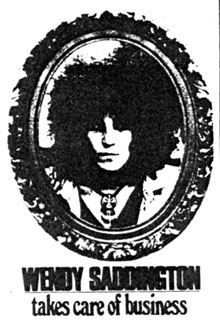 Saddington's Go-Set column, 1969-1970 Saddington's Go-Set column, 1969-1970 |
To a teenage girl, there was absolutely no end to the love and adoration expressed for a male pop hero but there was also the possibility to tip heaps of water on those they didn’t like. Because of the bias created to sell the magazine – male heroes for female fans - it really didn’t do justice to a growing band of genuinely great female stars of the period – Wendy Saddington, Liv Maessen, Lynne Randell, Dinah Lee to name a few who only occasionally made the pages. Wendy actually went on later to write a column for Go-Set and Randell, (1967-1970) while stationed in Los Angeles in 1970-1, became Go-Set’s American corespondent. The new choice of Saddington as a demure staff writer may have seemed a curious move:
PAUL CULNANE: “Curiously, one of Wendy's side-gigs around 1969 was to write a column for the lovelorn in Go-Set. Just imagine how incongruous, but delightful, that very concept seemed when wild Wendy first took on the mantle of "agony-aunt"! …But remember, back then when the mainstream press and most TV reporters witnessed such a supposedly crazed witch (in their eyes) as Wendy Saddington, and reported her activities with scorn and derision, you might understand that such unwarranted but intense spotlight scrutiny always seemed to deflect Wendy back into her complex shell. Meanwhile, Chain went on to build a solid reputation as Australia’s premier blues-rock band, while for a short time Wendy foundered, seemingly bewildered by all the attention her unique talents were garnering. But she pressed on.” (Culnane in www.milesago.com, January 2001, courtesy of Duncan Kimball)
Greg Quill, a Sydney-based writer/musician who was to go on to form the country/rock band The Dingoes with Broderick Smith and Kerryn Tolhurst, joined in a writing capacity looking after editorial duties for New South Wales. He explains the reasons for getting involved with the magazine:
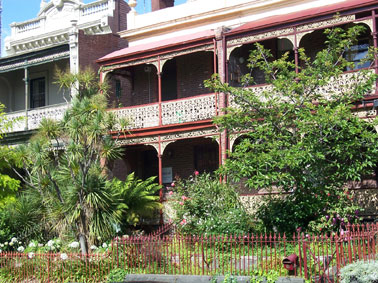 Go-Set moved from St. Kilda to Drummond Street, Carlton in the early ‘seventies. The magazine was then run from this terrace house at number 17. Here it stayed until it was packed up and moved to Sydney. |
GREG QUILL: “Straight after I came out of university, I applied for a job. I had heard there was something going at Go-Set. I was not familiar at all with the magazine, but I imagined that if I had a career anywhere, it was in writing somewhere, because the only real skills I had were as a writer. And this seemed to provide a link between my writing ability and my interest in music - although it was pop music, and I had really no time for pop music. But anyway, I ended up getting the job as NSW features writer, and I met David Elfick; he was the managing editor there at the time, of the NSW edition, and got in the Go-Set fold and ... quickly [laughs] learned how to deal with celebrities.
Actually that was a very important element of training for what I do now. Because for the 15 or 16 years I've been working at the [Toronto] Star, I've been working in the Arts area -- first as a music critic, then as a television critic, now as Senior Features Writer. I think I have an edge that other people don't, and that harks back to the Go-Set years, where at a very young age I was thrown into situations were I had to get real and affecting stories out of celebrities, and to make contact with them on a real and human level. And I think that served me well.” (Quill, Interview with John Broughton, www.milesago.com)
By the early ‘seventies, the “Dear Jandy” column dispensed advice and Suzi Quatro got a run in the pages. Staffer, Ed Nimmervoll remembers that the Go-Set receptionist at the time was a young girl named Jan. In 1972, Nimmervoll married and his wife, also named Jan spent a good deal of time at the Go-Set offices. This was at a period when the magazine had moved from its small and cramped offices in St. Kilda to more spacious premises in Drummond Street Carlton. So to avoid confusion around the place, the ladies became known respectively as, Jan “N” and Jan “D”. The latter name stuck and to all there, Jan “D” soon became “Jandy”. Like all those employed at Go-Set, she filled multiple roles at the organisational and writing levels. “Jandy” in her role as columnist, had to deal with some pretty bizarre stuff. How about this for an example!:
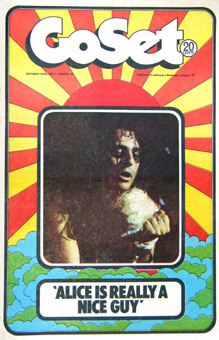 Go-Set cover, October 1972, Go-Set cover, October 1972,featuring Alice Cooper |
“Dear Jandy,
Who would possibly like that terrible group, Alice Cooper. For one, take ALICE. She can’t sing for nuts and SHE looks like a guy with make-up on. I don’t know HOW her first album “Billion Dollar Babies” got to number ONE – it’s hopeless. The SINGLE off that album, “School’s Out” is hopeless. I’m pretty sure that Alice Cooper is AUSTRALIA’S worst group.
Dianne.
JANDY … You’ve got
to be joking!! Sorry, but I’m speechless from still gaping in awe at this
ridiculous letter.”
(Go-Set, 28 July, 1973)
Jim Keays, glamourous frontman for The Masters Apprentices also contributed as an occasional reporter around town following the break-up of the ‘Masters. One such assignment took him to the Much More Ballroom in mid-winter, 1973 and he was less than impressed with the general scene there. He wasn’t to know at that time that the venue was nearing its end and although he was impressed with MacKenzie Theory and Alta Mira, The Dingoes seemed washed out and lifeless, according to Jim.
Terry Cleary, was actually hired to sell advertising space in Go-Set but this didn’t stop him doubling as a crystal-ball gazing psychic for the fortune-telling column – something which he obviously knew little or nothing about:
ED NIMMERVOLL: “You remember all of those who worked at Go-Set in a way. There was a guy called Terry Cleary who was the son of a football legend – Jim Cleary who played with South Melbourne and he was the original ad rep. He was a larger-than-life character. He’d sell the ads and he’d also make up the horoscopes and if you look at the horoscopes, he was just being really stupid and having his revenge on people and sending signals to girls. It was really his own little diary in a horoscope.” (Nimmervoll, op cit, 23 September, 2005)
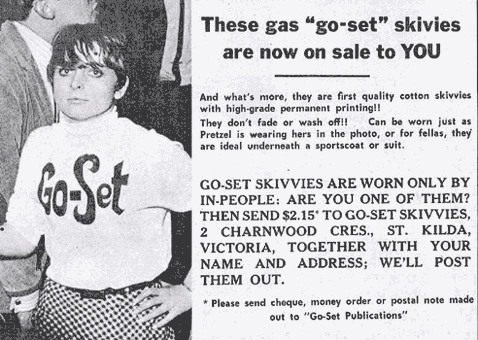 Advert in Go-Set, 1966 Advert in Go-Set, 1966 |
The major thrust of the write-in segments was to offer advice to teenage girls on their relationship problems – basically, how to catch a guy or how to let him go. Despite becoming a little more explicit as the years went on, the letters from the many lovelorn girls remained still almost plutonic in nature. (There was still an element of innocence about). It was interesting that the advice was usually given by writers and contributors with no counselling experience at all, however as the themes of the letters all had a thread common to adolescents of all eras, this posed few problems for the advisors. There were also the odd competitions and give -aways too:
MICHAEL EDMUNDS: “One day, we went to a Sydney TV station with one of our readers, who'd won a night out with Johnny Farnham. I doubt it would happen now; but, when we found him then, he was in a small, cluttered dressing-room, hardly appropriate for the meeting of star and fan. Naturally, we improvised. Johnnie Ray was doing a segment on the same show, to promote his club tour. "Mr Ray," we said, knocking on his dressing-room door. "Would it be OK if we borrowed the back end of your huge and luxurious suite to take a few photos of John meeting the winner of Go-Set's 'go out to dinner with Johnny Farnham' competition?" "Sure," he said. So we did.
The pictures were magic and glamorous. We were happy. John was happy. Our winner was happy. The readers were happy; and Johnnie Ray was happy because he got a mention, with our thanks, in a magazine that catered for his fans' children -- All of which points me to another unique quality in Go-Set's approach: We always tried to maintain the artists' image, as they felt, and as our readers wanted to see them. (Edmunds, op cit, www.4.tpgi.com.au)
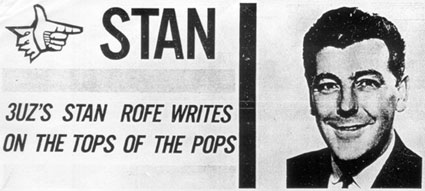 Stan Rofe's column in the first edition of Go-Set, February 1966 Stan Rofe's column in the first edition of Go-Set, February 1966 |
Go-Set brought some considerable clout to its already very influential magazine with the inclusions of Stan Rofe and Ed Nimmervoll, (as writer from 1966, then as Editor, 1972 - 73). “Stan the Man” lent his established credentials in the music business to the column, “Stan Rofe’s Tonic” which brought a level of “insider information” and authority to the job of commenting on the music news – thus a new level of serious comment and criticism began to appear in the paper. Nimmervoll had worked for Go-Set from 1966 when he started dropping his “National Charts” into the letterbox at Go-Set’s St. Kilda office on his way to his architecture course at R.M.I.T. in the city and after joining the team, moved on to feature articles. In 1972, when the publication was facing more major changes, he took over as editor.
He wrote the editorials which more than touched on the problems which beset the industry such as his 18 August, 1973 blast entitled, “Our records are too dear”. By then, Go-Set had matured and sought to break away from the direction it had established for itself – a music magazine for the younger teenage girls. The all important Go-Set National Top 40 singles and Top 20 Album charts appeared at a time when when they were studied as carefully as the weekend footy results. Success for an artist on the charts meant continuing success in record sales and one fed off the other.
 Advert for The Thumping Tum discotheque in Melbourne, 1966 Advert for The Thumping Tum discotheque in Melbourne, 1966 |
Around 1967, discotheques had blossomed in Melbourne as places for music-starved teens to go on a Friday or Saturday night to listen and groove to their rock and roll heroes. The musicians and singers appeared on stage in an atmosphere which was stimulating and exciting for many – this time for teenage boys, as well as girls. Discos were generally thought to be alcohol and drug free, but were often tight, dark, smoky, hot, sweaty places and sometimes reeked of burning incense and often pot smoke. They immediately drew criticism from parents who grew suspicious of the activities which their children could get caught up in, in these places. Frankly, some of them were decorated a little like New Orleans brothels - in a mixture of styles, but often predominately floral Art Nouveau with a touch of ‘sixties Carnaby Street kitsch.
They could also get a little rough and potentially dangerous at times, as fights sometimes broke out inside as well as outside the venues. Go-Set, in its editorialising mindset found itself in a position to defend the venues, the organisers, the activities and the kids who read their magazine from what they saw as unnecessary suspicion and unwanted criticism from the police.
By the ‘seventies, with a maturing readership, Go-Set felt the need to move on – with some external and internal influences creating the motivation for change. Some sort of upheaval at the magazine had to take place as many of the readers had now moved on to progressive rock and were highly critical of Go-Set’s stance on the ‘teen market and the directions music was taking. It still seemed Beatle-centric to many in an age where rock music had moved on and The T.F. Much Ballroom in Fitzroy reigned supreme as THE place to be in Melbourne. Go-Set for 20 March, 1974 featured “Go-Set Consumers Guide To The Beatles” yet nearly four years had passed since the great band’s break up and music tastes had matured. Some saw Go-Set as now very much pitched to a middle-of–the-road readership.
Rolling Stone magazine had entered the field in 1967 taking rock journalism to new heights – this was serious rock rather than frivolous pop and signified clearly that rock music, in all its forms and directions, was here to stay. Repercussions were felt in the Go-Set office as Rolling Stone created another benchmark for music in print. Eventually, Go-Set’s stablemate – another spin-off magazine, Revolution morphed into Australian Rolling Stone concentrating on more serious discussion and journalism.
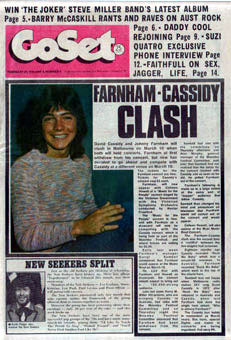 Go-Set cover, 23 February 1974 Go-Set cover, 23 February 1974 |
In its final and declining years, the influence that Go-Set had weilded in music circles in its earlier years was just not as strong as it had been, despite still featuring Australian artists and venues. Its decline as a teen-based newspaper was directly in proportion to the decline of the Melbourne city and suburban discotheques as clearly evidenced in the drop in advertisements – only Teaser and the Q Club were major advertisers in the pages of 1973’s Go-Sets. In order to sell copies, headlines became more eye-catching with a hint of sensationalism. Take the 23 February, 1974 edition as an example. The front page headlines screamed: “FARNHAM – CASSIDY CLASH” conjuring up the possibility of some sort of fisticuffs between the visiting star, David Cassidy and our own Johnny Farnham! But alas, after you’d bought your copy and read a little further, you’d find that the article was about nothing more than a clash of concert dates of both stars for 10 March in Melbourne. By the way, it was all part of “Music For The People” and Farnham’s gig was free while Cassidy’s had a top price tag of $3!
Costs dictated that many articles were not to be generic anymore, but taken from overseas publications and printed as they were. By late 1972, Waverley Offset Printers, which had always owned shares in Go-Set Pty Ltd, had gained full control of the magazine from Fraser in an effort to mop up spiralling debts and had installed its own man, Gavin Disney as the person in control. Go-Set had accumulated a substantial debt to Waverley Offset Printers quite early in its existence and despite channelling almost all of its profits back to its debtor, was never able to fully repay the debt. Waverley Offset placed Piotr Olszewski in as editor until it sold its interests to IPC Magazines. At this point, Ed Nimmervoll, now almost the sole surviving worker, was offered the job of editor:
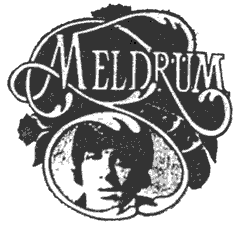 Ian Meldrum's column in Go-Set, 1970 |
ED NIMMERVOLL: “Music was changing and I was the person that seemed to have a grip on things because music was moving away from pop. Go-Set was originally a “pop paper” and it wanted to move with the times but didn’t quite know how. So for a while we invented a four-page insert, called “Core” and I became its editor. So that while Go-Set had been started by university students – Phillip Frazer – who had worked on the publishing side of university papers – it now had run up a huge debt with the printer, so now the printer called in that debt. At this time, all those who were there at the start were gone – Frazer had bought Rolling Stone and began to build up this large publishing interest. Only Ian (Meldrum) and I were left and we were only interested in the music side, not the publishing. So the publisher took over the magazine, bought in a representative and that representative offered me the job as editor.” (Nimmervoll, op cit, 23 September, 2005)
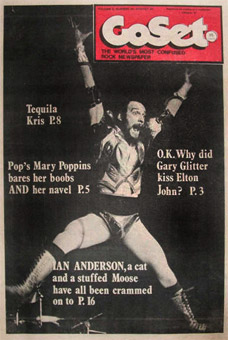 Final edition of Go-Set, August 1974 Final edition of Go-Set, August 1974 |
The final straw which was of great significance to the Melbourne scene was the eventual sale of Go-Set to Sungravure Press in 1974 and the shift to Sydney in a probable attempt to both shore up and fully nationalise the magazine. Sungravure was responsible for the distribution of the magazine in both states but it was still printed at Mulgrave by Waverley Offset Printing. Controlling decisions were now being made from the same office at 57-59 Regent Street, which created Dolly Magazine, and Go-Set was reduced to only two permanent staffers. This all really spelt the end for Go-Set. Lets face it, it had probably run its race before it was sold to Sydney interests. The times had moved on and now it was the moment for Go-Set to do the same. With the resignation of the last staff writer, Michelle Williams, in 1974, the decay was quite obviously complete and Go-Set had no choice but to go quietly, with what dignity it had left.
As a footnote, when the Drummond Street office had closed, occasional correspondent and writer, Jim Keays was there at the offices on the day that the order was given to “pack it all up”. For a few days, it was a chaotic scene as the floors quickly became littered with files, paper, photos, documents and other items, all waiting to be assigned to the nearest council tip. Very little of what had made Go-Set such an Australian music industry icon was saved. Several of the lucky photographers who were there in the final weeks managed to rescue some of their work and Keays grabbed several files of Masters Apprentices’ photos in order to preserve them. He remembers seeing much, if not all of the memorabilia, including many Go-Set Pop Poll awards just simply strewn across the first floor of the Drummond Street terrace awaiting disposal.
What then did this magazine add to the scene and what contribution did it make to the industry?:
MICHAEL EDMUNDS: “Four things, that speak for themselves -- and now that we don't have to use typewriters any more, we can bullet - point them, so you can decide their order of importance for yourself:
· We gave our readers a sense of excitement, and something to look forward to each week.
· We documented the world's, and especially Australia's, emerging youth culture until it reached its maturity in the early seventies.
· We tried to disseminate the wealth of youthful idealism that was available and promote the innovative projects it automatically entailed.
And...
· We gave young people as much information as we could
about what was going on in their world, and interpreted it for them as
objectively as we could, to help them develop informed opinions, and, by that,
become more effective.” (Edmunds, op cit, www.4.tpgi.com.au)
"So.. in the beginning the editor created Go-Set Magazine and the editor looked down on the growing music sensation, saw that it was good and in the fullness of time, Go-Set begat GAS magazine."
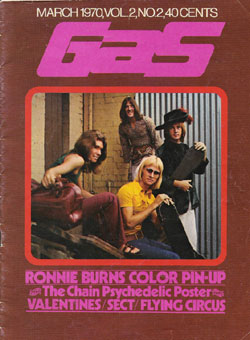 Gas Magazine, 1970 |
Gas was launched on the scene in October, 1968 by Go-Set’s guru Phillip Fraser who installed highly successful poster artist and cartoonist Ian McCausland as its first editor. Gas evolved over its short life from the broadsheet newspaper-style format to more of a glossy pictorial - along the lines of the colourful British Fabulous Magazine – down to a smaller magazine. Fabulous, an imported fanzine was available at certain Australian newsagents and featured sleek photo shoots of the emerging parade of British stars. It had heaps of glossy, colour pictures of The Beatles, The Rolling Stones, Herman’s Hermits, The Dave Clark Five, The Yardbirds, The Pretty Things, Them, Cilla Black, Dusty Springfield, Gerry and The Pacemakers, Brian Poole and the Tremeloes and The Kinks among a vast array of British Invasion stars whose popularity was soaring in Australia. I remember almost religiously picking up a copy of each new issue of Fabulous at a newsagent in Burwood Road, Hawthorn, opposite Swinburne College, as soon as it was released, when I was studying there at the time.
But, why another magazine by the Go-Set team? By 1968, the Go-Set readership had begun to mature and they were being strongly influenced by the new wave of Psychedelic music and fashion wafting out of San Francisco like some giant cloud of pot smoke drifting across the Pacific and Go-Set began to incorporate the readers’ needs within its pages. But, there was a whole new target audience of young teens emerging like the original Go-Set readers had a few years earlier and they wanted more of the glossy posters to pin up on bedroom walls, the backs of doors and ceilings above their beds, much to the chagrin of their parents. The decision was made by Go-Set staff and management to create an entirely new publication to meet this perceived need, rather than increase Go-Set in size and print quality.
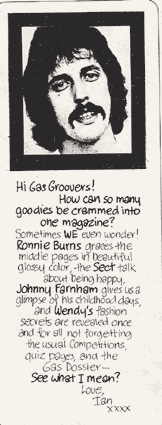
Ian McCausland, editor of Gas |
America’s Monkees, the
made-for-TV band that became a bonafide pop sensation in its own right all
around the world, had arrived on the scene and Gas picked up on the younger teen’s infatuation with the band, its hits
and its half-hour T.V series which began the phenomenon. The first edition of Gas coincided
with their tour of Australia in late-1968 and featured loads of pin-ups. This
inaugural edition was probably a pilot to test the waters before the magazine
settled into some sort of a regular format. Eventually Gas became
more stylish in presentation and established itself as a monthly publication –
the original black and white format giving way to full colour. It was certainly
more chatty and gossipy than the maturing Go-Set even though it shared
staff regulars with its parent magazine. Meldrum, Lily Brett, Wendy
Saddington, Stan Rofe, Jean Gollan, Greg Quill, Michele
O’Driscoll and David Efflick shared the writing duties. It was printed in the
standard offset method but, unlike its ‘parent’ newspaper was printed at Southdown
Press,
32 Walsh Street, Melbourne, which was better set up to accommodate the colour
printing process.
Meldrum had taken over as editor
from McCausland by 1969 and Gas became a smaller, possibly more
serious magazine increasing
its commitment to Australian bands and artists in response to the distinct and
healthy local scene which began to emerge by the mid- to late- sixties. By
February, 1971 however, Gas had run out of…. well.. gas! and had run its
race, while its sibling publication, the floundering Go-Set lurched
along until 1974, before heading to Sydney and eventual oblivion.
As a footnote, a potential rival magazine for Go-Set arose briefly in 1966/7 just around the same time as Go-Set was also setting out on the relatively untrodden pathway that was ‘teenage journalism’. More a ‘pretender to the throne’ than a serious rival, the magazine was titled Albert Sebastian. It became a shooting star which burned out and disappeared from the scene just as rapidly as it had risen. This magazine has long been thought to have eminated from the city discotheque of the same name, however, according to photographer Jim Colbert, there was no connection at all between this magazine and Sebastians in Exhibition Street, operated by the Knight family. Yet the similarities in nomenclature are uncanny and there may have been a tenuous connection back at the concept stage of this magazine which failed to materialise, leaving Albert Sebastian to go its own way.
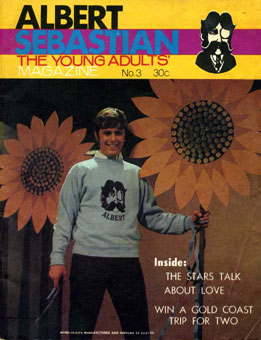 Albert Sebastian Magazine Albert Sebastian Magazine |
Colbert, who eventually became an eminent photographer with Go-Set from 1967 onwards, remembers being approached by Andrew Theophanous, a young man from a Greek Cypriot migrant family, to take a few photographs for the proposed publication. Operating under the name “Andrew Charles”, Theophanous, a Monash University Philosophy student, was one of the creators of the magazine which came out in quarto size; contrasting with Go-Set which was tabloid style and size. (Theophanous would eventually go on to become a long-serving Federal Labor, then Independent Member of Parliament from 1980 to 2001, but in a strange twist of fate, fell from grace after court investigations into his conduct as a MP in 1999. He is the brother of Theo Theophanous, also a politician and Victorian State Minister for Energy Industries and Resources in the Steve Bracks’ Labor Government.)
At the start, Andrew Theophanous was joined by Joseph Zayda and George Koumpan in getting the magazine underway for what was a dazzling start, but would in reality be a very short run. Printed on the same presses at Waverley Offset Printers as Go-Set, it lasted a mere thirteen issues before it folded. Colbert recalls only being employed by the magazine for about three or four months before going over to Go-Set early in January, 1967. Many of the photos in the magazine were taken by Colbert, Ric Hawkins and Geoff Davidson with the latter being the main contributor. Colbert recalls that no one managed to get paid anything for their services and he doesn’t remember seeing the magazine on the streets after he went to work at the Go-Set offices. (Colbert, email correspondence, 2 May, 2006). However, the magazine continued on until nearly Christmas, 1967 though it would seem that it attracted declining interest from the public.
What future the owners/publishers envisaged at the start for Albert Sebastian is not known, however, by the end of 1967 it had sunk into oblivion leaving Go-Set to emerge as the sole Melbourne authority on ‘teen music, attitudes and trends for nearly a decade.
© Copyright: Jeffrey Turnbull.


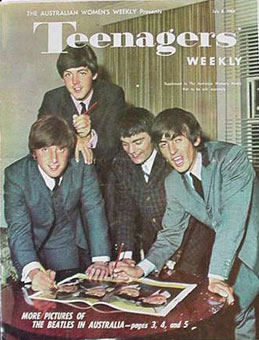 Likewise, the “glossies”, Woman’s
Day and Women’s Weekly catered for the maturing female audience
sometimes picking up on a selected youth story when it suited circulation
purposes and increased sales. Only People Magazine, Pix and Australasian
Post which
were all a little more on the sensational side, catered in some way for the
curiosity value of the new teen attitudes, fashions and trends but were
still adult magazines just aimed at
the voyeuristic curiosity in many adults, if they were willing to admit it.
Those youngsters featured were not actually their children so
it was worth a peep at these “teenagers gone wrong” . People and Pix appealed
to similar readerships at the height of their popularity over the two decades
of the ‘sixties and the ‘seventies and seemed keen to outdo each other in the covers, photos and
stories they presented. They seemed to get more daring as time went by. Stories
featured extra-marital affairs, stars and starlets and covers which moved from
near nudity to total nudity ( oh… but don’t show any pubic hair!) until the two
magazines, which to all intents and purposes, were travelling in the same
direction actually merged to become one in 1971.
Likewise, the “glossies”, Woman’s
Day and Women’s Weekly catered for the maturing female audience
sometimes picking up on a selected youth story when it suited circulation
purposes and increased sales. Only People Magazine, Pix and Australasian
Post which
were all a little more on the sensational side, catered in some way for the
curiosity value of the new teen attitudes, fashions and trends but were
still adult magazines just aimed at
the voyeuristic curiosity in many adults, if they were willing to admit it.
Those youngsters featured were not actually their children so
it was worth a peep at these “teenagers gone wrong” . People and Pix appealed
to similar readerships at the height of their popularity over the two decades
of the ‘sixties and the ‘seventies and seemed keen to outdo each other in the covers, photos and
stories they presented. They seemed to get more daring as time went by. Stories
featured extra-marital affairs, stars and starlets and covers which moved from
near nudity to total nudity ( oh… but don’t show any pubic hair!) until the two
magazines, which to all intents and purposes, were travelling in the same
direction actually merged to become one in 1971.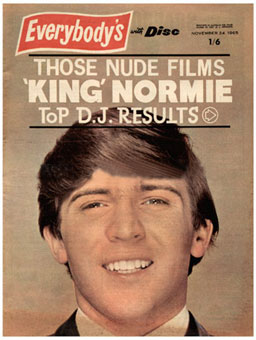 Everybody’s Magazine was really
the ultimate magazine for Australia’s popular culture throughout the pre-Go-Set, early
‘sixties because it covered the biggest stars of the period and wasn’t afraid
to feature young Australian rock stars. It was published by the Packer
organisation in Sydney but its circulation was national and in fact
international, as it reached New Zealand readers. It did, however lean towards
the Sydney scene. Kiwi musicians Mike Rudd (Spectrum and
Ariel)
and Glyn Mason (Ariel, Chain, Copperwine, Stockley See
& Mason) have both spoken of the influence which Everybody’s had on New
Zealanders in informing them of the swingin’ scene in Australia. Just to read
about what was happening in Australia was enough to convince them to relocate
across the Tasman Sea with their respective New Zealand Bands, Chants R
& B and Larry’s Rebels.
Everybody’s Magazine was really
the ultimate magazine for Australia’s popular culture throughout the pre-Go-Set, early
‘sixties because it covered the biggest stars of the period and wasn’t afraid
to feature young Australian rock stars. It was published by the Packer
organisation in Sydney but its circulation was national and in fact
international, as it reached New Zealand readers. It did, however lean towards
the Sydney scene. Kiwi musicians Mike Rudd (Spectrum and
Ariel)
and Glyn Mason (Ariel, Chain, Copperwine, Stockley See
& Mason) have both spoken of the influence which Everybody’s had on New
Zealanders in informing them of the swingin’ scene in Australia. Just to read
about what was happening in Australia was enough to convince them to relocate
across the Tasman Sea with their respective New Zealand Bands, Chants R
& B and Larry’s Rebels.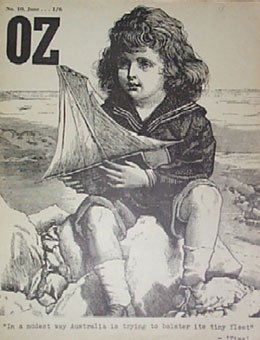 Universities were hotbeds of
radicalism in the ‘sixties with Vietnam War draft resisters being sheltered on
campus at Melbourne University. The twin scourges of the National Draft
(“Conscription”) for healthy 20-year old males and the continuing conflict in Vietnam became
explosive material at these establishments. Graduates who have attended Monash
University would undoubtedly remember Lot’s Wife, the campus
newspaper emanating from the Student Union Building at Clayton. This student
stronghold, in the 60’s and 70’s was THE place between lectures and tutorials
for any long-haired, bearded male to hang out and meet chicks. Lot’s Wife, in the
sixties was a radical, student newspaper reflecting the more extreme political
views of the students, many of whom dabbled in elements of active socialism.
This campus newspaper, while pushing the boundaries of just what information
dissemination was about at the time, also hooked into satire and ridicule, particularly directed at our Liberal politicians such as Billy McMahon, John Gorton, Robert Menzies and of
course, Victorian Premier, Henry Bolte. Lot’s Wife mirrored
the more generally available alternate publications (but still a bit under the
counter) such as
Universities were hotbeds of
radicalism in the ‘sixties with Vietnam War draft resisters being sheltered on
campus at Melbourne University. The twin scourges of the National Draft
(“Conscription”) for healthy 20-year old males and the continuing conflict in Vietnam became
explosive material at these establishments. Graduates who have attended Monash
University would undoubtedly remember Lot’s Wife, the campus
newspaper emanating from the Student Union Building at Clayton. This student
stronghold, in the 60’s and 70’s was THE place between lectures and tutorials
for any long-haired, bearded male to hang out and meet chicks. Lot’s Wife, in the
sixties was a radical, student newspaper reflecting the more extreme political
views of the students, many of whom dabbled in elements of active socialism.
This campus newspaper, while pushing the boundaries of just what information
dissemination was about at the time, also hooked into satire and ridicule, particularly directed at our Liberal politicians such as Billy McMahon, John Gorton, Robert Menzies and of
course, Victorian Premier, Henry Bolte. Lot’s Wife mirrored
the more generally available alternate publications (but still a bit under the
counter) such as 